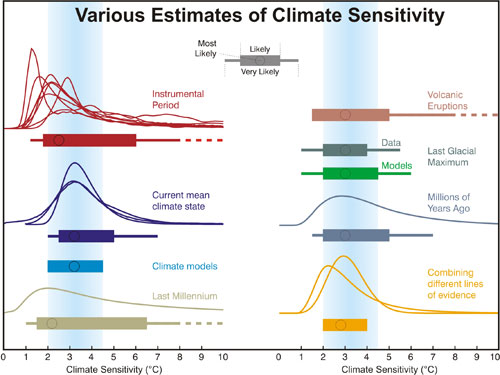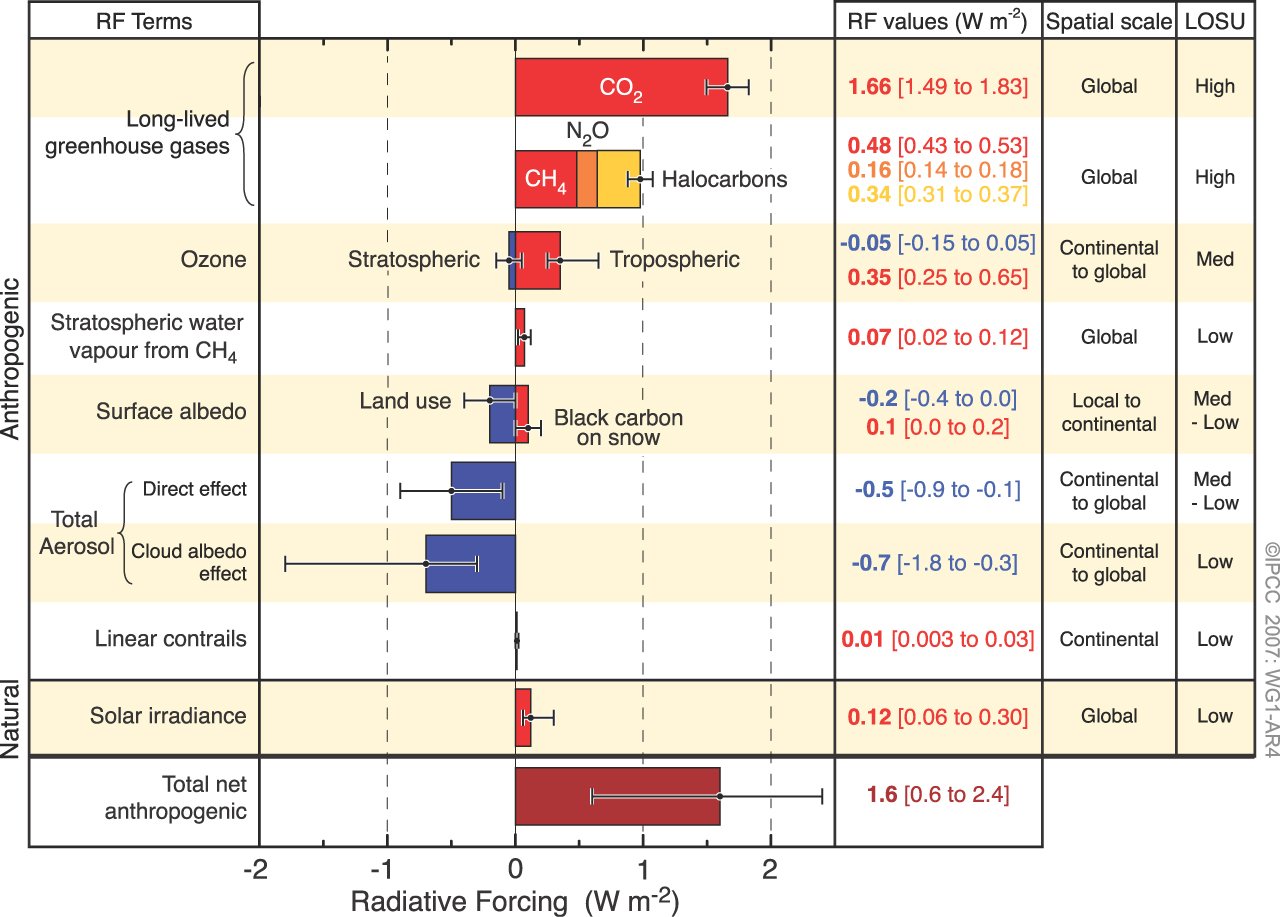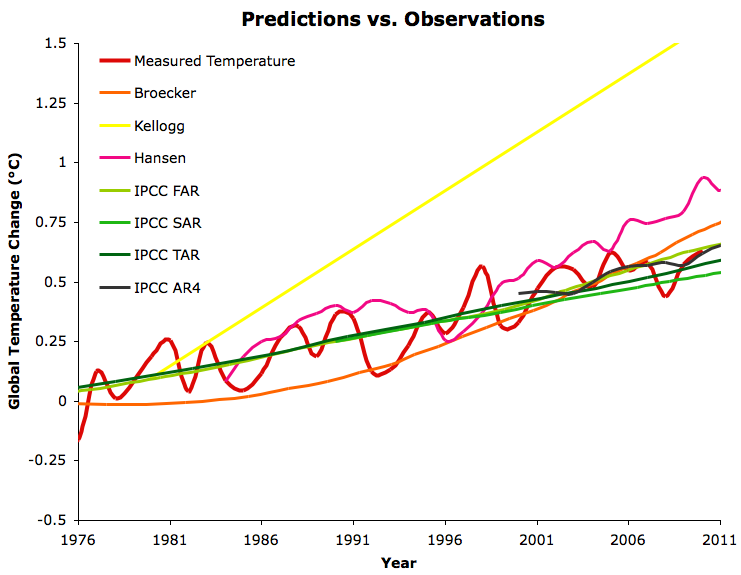Lindzen's Sandia Talk Contains his Usual Errors
Posted on 1 August 2012 by dana1981
 Here we go again. Richard Lindzen was invited to give a talk at Sandia National Laboratories as part of their Climate Change and National Security Speaker Series. In that series, Sandia sought to "shed light on the wide spectrum of thought regarding the causes and extent of changes in Earth’s climate," which explains why they chose to invite Lindzen despite his long history of being wrong on climate science issues. Lindzen is one of the few 'skeptic' scientists with an extensive resume of climate research - as Anderegg (2010) showed, there are few to choose from.
Here we go again. Richard Lindzen was invited to give a talk at Sandia National Laboratories as part of their Climate Change and National Security Speaker Series. In that series, Sandia sought to "shed light on the wide spectrum of thought regarding the causes and extent of changes in Earth’s climate," which explains why they chose to invite Lindzen despite his long history of being wrong on climate science issues. Lindzen is one of the few 'skeptic' scientists with an extensive resume of climate research - as Anderegg (2010) showed, there are few to choose from.
Unfortunately, in his Sandia talk Lindzen repeated most of the same long-debunked climate myths that he has been making for over two decades. As usual, Lindzen's talk centered around his favorite myth which we have debunked many, many times, starting with Lindzen Illusion #1: We Should Have Seen More Warming.
It's easy to understand why Lindzen insists on repeating this myth, because it's the basis of his argument that climate sensitivity (the amount the global temperature will change in response to increasing CO2, including feedbacks) is low, which in turn is the lynchpin for all climate contrarianism. However, despite its importance to Lindzen and his fellow climate contrarians, it is simple to show why Lindzen's "Earth should have warmed more" argument is wrong along every step of the way.
1. Lindzen claims "We’ve already seen almost the equivalent of a doubling of CO2 (in radiative forcing)."
In reality the net radiative forcing is most likely less than halfway to the equivalent of a doubling of CO2.
2. Lindzen claims "that [radiative forcing] has produced very little warming"
In reality the amount of warming we've observed is consistent with a climate sensitivity in the range cited by the IPCC.
3. Lindzen concludes that his argument proves climate sensitivity must be low.
In reality aside from Lindzen's arguments being wrong, the full body of evidence points to much higher climate sensitivity than Lindzen believes.
1) Halfway to Doubled CO2
Lindzen's claim that we have almost reached the equivalent radiative forcing (global energy imbalance) associated with a doubling on atmospheric CO2 is based on cherrypicking. Quite simply, he is only looking at the radiative forcing associated with CO2 and other greenhouse gases (GHGs), ignoring all other radiative forcings. The problem with this is that the climate responds to the net radiative forcing, not just to GHGs.
Even ignoring other radiative forcings, Lindzen's argument is still wrong. According to the NOAA Annual Greenhouse Gas Index, the GHG radiative forcing (relative to 1750) in 2010 was 2.81 W/m2 - only 76% of the way to doubled CO2-equivalent.
However, the second-largest single radiative forcing (behind CO2) is most likely associated with aerosols, which have a strong net cooling effect by blocking incoming solar radiation both directly and indirectly (by seeding clouds). There is also an associated warming effect from black carbon, which darkens the planet's surface, causing it to absorb more incoming solar radiation. As Lindzen notes, the overall magnitude of these three effects is highly uncertain, but Lindzen approaches this uncertainty incorrectly by treating aerosols as if they have zero forcing with zero uncertainty. In reality there is a wide range of possible values, which according to the 2007 IPCC report lies between -0.2 and -2.7 W/m2, with a most likely value of -1.1 W/m2 (Figure 1). Note that Lindzen's assumed value of zero for the net aerosol forcing falls outside of this range.
Figure 1: Global average radiative forcing in 2005 (best estimates and 5 to 95% uncertainty ranges) with respect to 1750. Source (IPCC AR4).
Figure 1 also gives the range of likely values for the net radiative forcing in 2005 (with respect to 1750), which ranges from 0.66 to 2.7 W/m2 with a most likely value of 1.72 W/m2 (anthropogenic plus natural). The radiative forcing associated with a doubling of atmospheric CO2 is approximately 3.7 W/m2; therefore, we are between 18% and 73% of the way to the equivalent of a doubling of atmospheric CO2, with a most likely value of 46% (although the net forcing has continued to rise since 2005 due to continued human GHG emissions, so we are now in the ballpark of 50%). Note that the maximum value here (73%) is well below Lindzen's claim that "we’ve already seen almost the equivalent of a doubling of CO2."
Thus when we consider all influences on global warming, it becomes clear that Lindzen's claim that we are near the equivalent doubling of CO2 is most likely wrong by a factor of two.
2) Earth Has Warmed as Expected
In addition to the influences of non-GHG radiative forcings, the thermal inertia of the oceans is another effect that Lindzen has completely neglected.
Due to the fact that much of the Earth is covered in oceans, and it takes a long time to heat water, there is a lag before we see the full warming effects of any radiative forcing. In fact, we know there remains unrealized warming from the GHGs we've already emitted because there is a global energy imbalance. The amount of unrealized warming is dependent upon the amount of CO2 in the atmosphere (or other radiative forcing causing the energy imbalance) and the thermal inertia of the oceans (which causes a lag before the warming is realized). In fact, Lindzen admitted as much in his 2005 testimony to the UK Parliament House of Lords Economic Affairs Committee, explaining:
"the oceans' heat capacity leads to a delay in the response of the surface"
Lindzen proceeded to argue that this delayed response was insufficient to explain the difference between observed and expected global warming, but this is simply wrong as well. In reality, most past climate models with climate sensitivities consistent with the IPCC range predicted the subsequent global warming with a high degree of accuracy (Figure 2).
Figure 2: Various best estimate global temperature predictions evaluated in the 'Lessons from Past Climate Predictions' series vs. GISTEMP observations (red).
As Figure 2 shows, the Earth has warmed consistent with climate scientists' expectations.
3) Climate Sensitivity is Relatively High
In the end, Lindzen's argument that climate sensitivity is low because the Earth hasn't warmed as much as expected is wrong because he overestimates the net radiative forcing by a factor of two and ignores the thermal inertia of the oceans.
However, we should also note that there is a very large body of climate sensitivity research using many different lines of evidence, all of which point to a sensitivity in the range cited by the IPCC (Figure 3).

Figure 3: Distributions and ranges for climate sensitivity from different lines of evidence. The circle indicates the most likely value. The thin colored bars indicate very likely value (more than 90% probability). The thicker colored bars indicate likely values (more than 66% probability). Dashed lines indicate no robust constraint on an upper bound. The IPCC likely range (2 to 4.5°C) and most likely value (3°C) are indicated by the vertical grey bar and black line, respectively. Adapted from Knutti and Hegerl (2008).
Note that some of the estimates in Figure 3 come from models, others are based on recent observational data, and others are based on data from the distant past. All are consistent with the IPCC range of 2 to 4.5°C global surface warming in response to an equivalent of doubled atmospheric CO2, whereas Lindzen argues the sensitivity is below 1°C for doubled CO2. This is inconsistent with the body of scientific research. Thus the correct conclusion is that if Lindzen is correct about low climate sensitivity, we should already have seen much less warming than we have seen thus far.
Lindzen's Double Standard
In a moment of irony, at one point in his Sandia Labs presentation Lindzen claimed that for 30 years, climate scientists have been "locked into a simple-minded identification of climate with greenhouse-gas level," claiming that climate researchers have effectively ignored all non-GHG climate influences.
Given that Lindzen's entire argument is premised on ignoring all non-GHG radiative forcings, this is a rather glaring double standard. More importantly, it is also entirely false. For example, Figure 1 above shows that the IPCC has considered a wide array of non-GHG influences on the climate, and devotes a great deal of discussion to both natural and human-caused climate influences.
Climate scientists have focused a lot of research on the climate effects of aerosols, black carbon, solar irradiance, volcanoes, natural cycles, and many other climate influences. Lindzen's criticism of climate scientists ignoring non-GHG effects has no basis in reality, but it quite accurately describes his own arguments.
Lindzen's Repeated Errors
The mistakes Lindzen keeps making in his presentations are not complicated ones. Ignoring all non-GHG forcings and the thermal inertia of the oceans are two glaring errors which any good climate scientist should immediately recognize. On the contrary, Lindzen has been making these same wrong assertions in talks since at least 1989, and has continued making them at minimum on an annual basis since 2002.
This behavior is simply unacceptable. Every time Lindzen gives a climate talk, he is misinforming his audience by repeating these indisputably wrong claims. Until he corrects these errors, Lindzen is doing a disservice to every audience that invites him to speak.
While Sandia Labs sought to "shed light on the wide spectrum of thought regarding the causes and extent of changes in Earth’s climate", unfortunately Lindzen has instead spread the darkness of long-debunked myths and misinformation.































 Arguments
Arguments

























 0
0  0
0






Comments